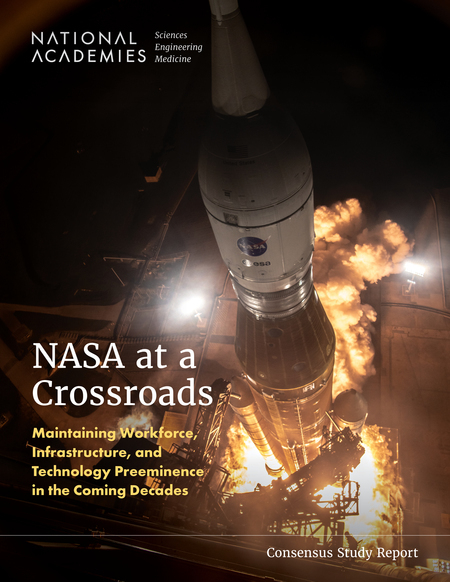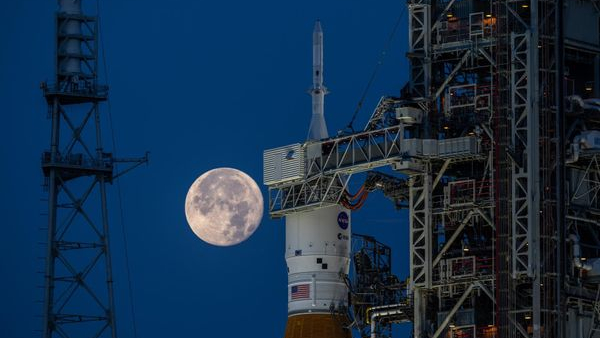'NASA at a crossroads:' Budget woes, aging infrastructure and hard choices ahead
"This is not a time for business as usual."

The next few years are likely to be pivotal ones for NASA, according to a hard-hitting report by the U.S. National Academies of Sciences, Engineering, and Medicine.
The report, which was released last month, is called "NASA at a Crossroads: Maintaining Workforce, Infrastructure and Technology Preeminence in the Coming Decades." And that title was chosen advisedly.
"The bottom line of all this, I think, would be to say that, for NASA, this is not a time for business as usual," said Norm Augustine, committee chair and former Lockheed Martin CEO, during a Sept. 10 webinar that detailed the report's findings.
"The concerns that it faces are ones that have built up over decades," Augustine said. "NASA truly is, in our view, at a crossroads, and that's why we put that word in the title."
Rebalance its priorities
The report identifies out-of-date infrastructure, pressures to prioritize short-term objectives, budget mismatches, inefficient management practices and nonstrategic reliance on commercial partners as the core issues.
The report also argues that NASA should rebalance its priorities and increase investments in its facilities, expert workforce and the development of cutting-edge technology, "even if it means forestalling initiation of new missions."
Breaking space news, the latest updates on rocket launches, skywatching events and more!
Indeed, the environment in which NASA functions today is complicated by several factors, including:
- Rapid advancements in technology
- The need to compete for talent with the commercial space sector, other space agencies and other high-tech sectors
- A declining federal discretionary budget and a flat agency budget (in terms of purchasing power)
- Lack of timely congressional authorization acts
- Shortfalls in the nation's education system, from pre-K through high school
- Increasing competition in space from China
Continued success at NASA is at risk, the report stresses, due to budget and program mismatch, short-term focus and aging infrastructure.
Space.com asked several space policy experts about their reactions to the report's conclusions.
Comes down to money
The story of NASA's infrastructure woes is all too familiar, said Marcia Smith, editor of the respected website SpacePolicyOnline.com.
"What I did find new was the report telling NASA that the problem is so acute that NASA needs to fix it even if that means forgoing new missions," Smith said. "NASA is well aware of its aging infrastructure. It all comes down to money."
The space agency's ongoing quest for funding is a situation that has only gotten worse, said Smith.
Last year, Congress abruptly started cutting NASA's budget — 2% less in fiscal year 2024 than in fiscal year 2023 (not accounting for the effects of inflation) — after years of growth, Smith pointed out.
Budget caps
"The agency is looking at canceling missions, never mind starting new ones. I don't know what they can do about infrastructure in this budget climate," Smith added.
The budget caps set by the Fiscal Responsibility Act last year are only for fiscal year 2024 and fiscal year 2025. Which party wins the House, Senate, and White House in November, Smith observed, will have a major effect on whether those caps are lifted after that and NASA gets more breathing room.
"If so, it will be interesting to see if NASA heeds Augustine's advice and fixes infrastructure instead of starting more missions. It does seem to be an either-or choice," Smith said.
What kind of NASA is needed?
The report is well-written and an accurate description of the many issues facing NASA as an institution, said Scott Pace, professor of the Practice of International Affairs and Director of the Space Policy Institute at The George Washington University in Washington, D.C. Pace served as the executive secretary of the National Space Council from 2017 to 2020.
Pace added, however, that the report "accepts as given that the agency as it has existed should continue, albeit with some repairs." The report does not ask, he said, what kind of NASA is needed for the 21st century?
"It takes an 'institution-driven' perspective, rather than being 'mission-driven' in asking what the United States wants NASA to be," Pace told Space.com.
"In light of changing private sector capabilities, what internal capabilities does NASA require to perform its missions? The report suggests one set of answers, but it is unclear that the Administration or Congress will agree," said Pace.
Hard choices
All in all, the report recommends tough but necessary medicine, suggested John Logsdon, professor emeritus at the Space Policy Institute.
"What strikes me is the absence in the report of a recommendation to increase NASA's funding in order to avoid 'trying to do too much with too little.' That was a recommendation of the two previous Augustine-led NASA committees," said Logsdon.
This iteration of a NASA review, Logsdon said, accepts that the agency's budget is unlikely to increase significantly in coming years.
"That implies hard choices with respect to which prospective missions not to do. On top of that, the committee recommends a reprioritization between carrying out spaceflight missions and tending to institutional health. This is antithetical to NASA's culture, which values mission success," Logsdon concluded.
NASA response
As for NASA's comeback on the report, that's still to come.
The report was requested by Congress in the Creating Helpful Incentives to Produce Semiconductors (CHIPS) and Science Act of 2022.
The study was undertaken by the Academies Committee on NASA Mission Critical Workforce, Infrastructure, and Technology and sponsored by NASA.
"The Congressional direction gave the agency 180 days to respond with a plan, said Colleen Hartman, senior managing director of aeronautics, astronomy, physics, and space science for the National Academy of Sciences, Engineering and Medicine.
"I also always request an agency response to a report, which will come separately to us," Hartman told Space.com.

Leonard David is an award-winning space journalist who has been reporting on space activities for more than 50 years. Currently writing as Space.com's Space Insider Columnist among his other projects, Leonard has authored numerous books on space exploration, Mars missions and more, with his latest being "Moon Rush: The New Space Race" published in 2019 by National Geographic. He also wrote "Mars: Our Future on the Red Planet" released in 2016 by National Geographic. Leonard has served as a correspondent for SpaceNews, Scientific American and Aerospace America for the AIAA. He has received many awards, including the first Ordway Award for Sustained Excellence in Spaceflight History in 2015 at the AAS Wernher von Braun Memorial Symposium. You can find out Leonard's latest project at his website and on Twitter.


